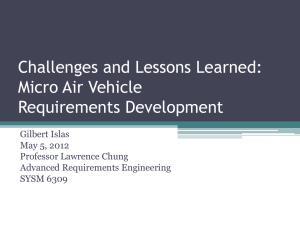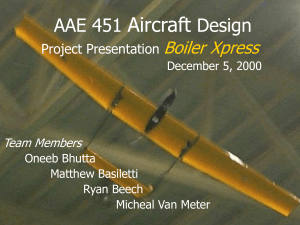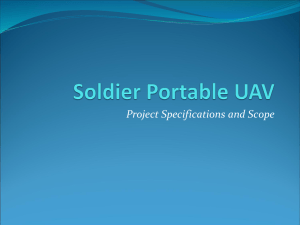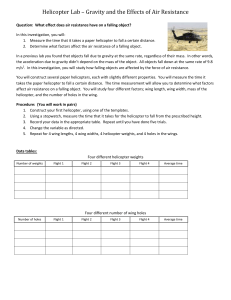MICRO AIR VEHICLES (2)
advertisement
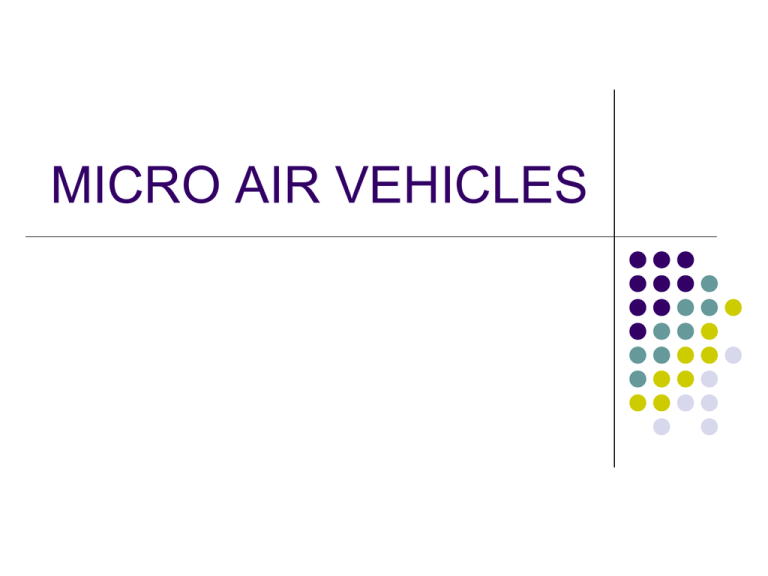
MICRO AIR VEHICLES WHAT ARE MAVS(AV’S)? Multi functional, militarily capable, small flight vehicles. size should be less than15cms. Reynolds's no < 10^5. For a Primarily intended and developed for defence applications. WHY MAV’S? WHY NOT SOMETHING BIGGER? Keeps security personnel out of harms by providing situational awareness right down to platoon level. Direct connectivity Can be individually controlled Can be used for a wide range of new missions _ (even unthought-of before) APPLICATIONS Reconnaissance Surveillance Defence applications Weather forecast Wildlife study &photography Crowd control Targeting Border surveillance Traffic monitoring Tracking criminals & illegal activities Biochemical sensing inspection of pipes OVER THE HILL RECONNAISSANCE MOTHER BIRD APPROACH Tracking of chemicals MAIN SUB SYSTEMS 1. FLIGHT CONTROL 2. PROPULSION SYSTEM 3. COMMUNICATION SYSTEM 4. GUIDANCE&NAVIGATION MAV flight regime compared with existing flight vehicles FLIGHT CONTROL&AERODYNAMICS Reynolds's no:= inertia force/viscous force Low Reynolds's no: flights may have lift to drag ratio of 5 to 10. The best aspect ratios usually lie between 1&2 Angle of attack should be 5-12° for good endurance. If angle of attack <5, low aerodynamic efficiency Endurance=/power requirement For optimal endurance the mav should fly at7° ACTIVE OR PASSIVE CONTROL Use strategies using MEMS Create &install tiny sensors miniature actuators Flow character controlled by sensor arrays Flexible membranes or micro flaps to affect the flow as required Micro motors piezoelectric devices magneto elastic ribbons WING DESIGN AND FABRICATION Types of wings wing shapes Composite materials, Carbon fibres carbon fibre-balsawood sand witches are commonly used Inflatable wing Distend (fill) with air or gas Application in UAV, military To stow the wings Can be launched from gun or aircraft Advantages of aircrafts with inflatable wings Can be packed to 1/10 of original size Low mass Low power requirements High reusability It can be steered, accelerated, and decelerated in level flight. High stability and control High lift and slow landing speed Experiment on inflatable wing Experiment conducted using I 2000 It was launched from 800-1000 feet Inflatable wings comes out in 1\3 sec Successfully controlled the launch,flight and landing Controlling of wing by using piezoelectric material actuator can be quartz and substrate can be aluminum or steel inflatable wings has smooth surface so low value of skin friction I-2000 & X-24A Both have inflatable wing I-2000 is UAV X-24A is manned Disadvantages They are not self powered Cannot launch from ground There are chances of air bag buckling PROPULSION SYSTEM Propulsion system alone consumes 90% of total power Lithium alkaline batteries IC engines Reciprocating chemical muscle Lithium battery that recharges using solar energy and fuel cells are also future prospects Self consuming systems COMMUNICATION SYSTEM A video/still camera, various sensors, micro processors, Transducers & an omni directional antennae GUIDANCE AND NAVIGATION A combination of GPS+inertial sensing is ideal Geographical information system to provide a map terrain for infrastructure would be great Pressure sensors MAV SYSTEM INTEGRATION



